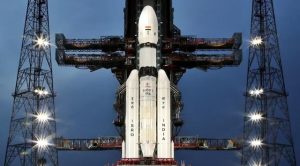Chandrayaan-3: India’s Third Moon Mission Sets Course for Lunar Landing
Chandrayaan-3, India’s third mission to the moon and second attempt at a gentle landing, successfully launched on July 14 at 2:35 pm from the Satish Dhawan Space Centre in Sriharikota. The Launch Vehicle Mark 3 (LVM 3) rocket carried the spacecraft into space.
The rocket took off smoothly and according to plan, with the different stages separating correctly. Once the satellite entered its orbit without any issues during its flight, ISRO declared the Chandrayaan-3 mission a success.

The countdown for the launch began 25.30 hours earlier, attracting over 10,000 spectators from Tamil Nadu, Andhra Pradesh, and Karnataka. They gathered at Sriharikota to witness the historic event from the dedicated space gallery set up by ISRO near the main entrance of the space center.
Before the scheduled launch, ISRO conducted a thorough review of the mission’s readiness. They also carried out a Launch Rehearsal to simulate the entire launch process.
Chandrayaan-3 consists of a lander, a rover, and a propulsion module, weighing approximately 3,900 kilograms. The LVM 3 has traveled 384,000 kilometers already and will land on the moon’s surface between August 23 and 24.
If successful, Chandrayaan-3 will place India among the elite group of countries, including the US, Russia, and China, that have achieved lunar landings. The Chandrayaan program was initially announced on August 15, 2003, by former Prime Minister Atal Bihari Vajpayee.
Chandrayaan-1, the first mission, launched on October 22, 2008. It confirmed the presence of water molecules on the moon’s surface but ended on August 28, 2009, after the Moon impact probe crashed near the lunar South Pole.
Chandrayaan-2, the second mission, launched on July 22, 2019, and entered lunar orbit on August 20, 2019. Unfortunately, the Vikram Lander lost contact with ground stations at an altitude of 2.1 kilometers from the lunar surface, impacting India’s reputation as a spacefaring nation.
Chandrayaan-3 is a continuation of the second lunar mission and is expected to overcome the challenges faced in the previous missions. It is a significant mission for India, aligning with the government’s efforts to promote investment in space launches and satellite-based businesses.
The mission includes eight payloads, with the Vikram lander carrying four instruments, the Pragyan rover carrying two, and the Propulsion Module or Orbiter carrying one experiment.
The propulsion module, along with the lander, will embark on a month-long journey to reach the moon’s orbit, eventually reaching an altitude of 100 kilometers above the lunar surface.
Once at the desired altitude, the lander module will begin its descent for a gentle landing in the moon’s south pole region, expected to occur on August 23 or 24, as stated by ISRO scientists.
